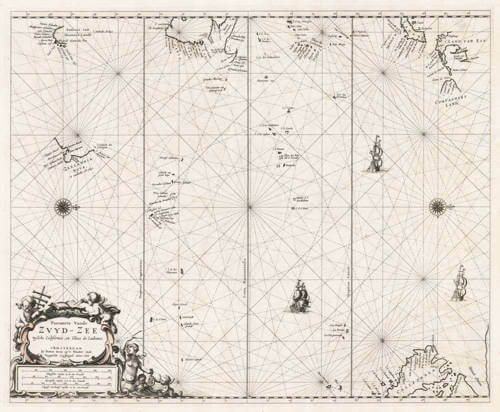Leen Helmink Antique Maps
Old books, maps and prints by Pieter Goos
Pieter Goos (1616-1675)
Pieter Goos: A Master Cartographer of the Dutch Golden Age
Early Life and Background
Pieter Goos, born in 1616 in Amsterdam, was a significant figure in the cartographic history of the Netherlands during the early 17th century. He was the son of Abraham Goos (1590–1643), who was also a renowned cartographer, map seller, and engraver. Abraham Goos had worked in Antwerp before moving to Amsterdam, where he contributed to the vibrant cartographic scene by publishing maps and globes, often in collaboration with other notable figures like Jodocus Hondius and Johannes Janssonius. This familial background provided Pieter with a rich heritage in mapmaking, setting the stage for his own illustrious career.
Pieter's mother, Stijntgen Theunisdaughter de Ram, and his family connections, including his uncle Pieter van den Keere, further immersed him in a milieu where cartography was not just a profession but a family tradition and skill. Growing up in Amsterdam during the Dutch Golden Age, a time when the city was a bustling hub of commerce, art, and science, Pieter was exposed to the latest techniques in engraving, printing, and map production from a young age.
Career and Contributions
Pieter Goos began his career following in his father's footsteps, initially focusing on creating pilot books which were essential navigational aids for sailors. These books included detailed charts and instructions for navigation, particularly around the Mediterranean, which were crucial for the Dutch maritime trade that dominated the period. His early work was marked by a notarized agreement with Jacob Lootsman and Hendrick Doncker to publish these pilot books, ensuring their validity and distribution from 1643 to 1680.
In 1666, Pieter Goos made a significant leap in his career with the publication of his "De Zee-Atlas ofte Water-Wereld" (The Sea Atlas or Water World), which is considered one of the finest maritime atlases of its time. This atlas was not only a compilation of the latest navigational knowledge but also a work of art, featuring richly colored maps with detailed illustrations of ships, compass cards, and wind roses. The atlas was so well-regarded that it dominated the Dutch market until the 1670s, when the Van Keulen family began to rise in prominence.
Goos's maps were known for their accuracy and aesthetic appeal, with embellishments like large descriptive cartouches that added to their decorative value. His work was not limited to sea charts; he also ventured into mapping land areas, with his atlas "Atlas ofte Water-Weereld" being noted for its comprehensive coverage of the known world's coastlines. Goos was innovative in his approach, being the first to map Christmas Island, which he named "Mony" on his 1666 map of the East Indies.
Legacy and Influence
Pieter Goos's influence extended beyond his lifetime. His son, Henrik Goos, continued the family tradition in cartography and publishing, ensuring that the Goos name remained synonymous with quality mapmaking. After Pieter's death in 1675, his widow managed the business for a short period, maintaining the high standards set by Goos. The maps created by Goos were used well into the 18th century, showcasing the enduring value of his work. However, later evaluations pointed out some inaccuracies, particularly in the depiction of geographical features like sandbars and islands in areas like the Gulf of St. Lawrence.
Goos's work was not just functional; it was also a status symbol. His atlases were printed on thick paper, often with gilding, making them desirable items for decoration in homes and offices of the affluent. This dual purpose of utility and decoration reflects the broader trend in Dutch cartography of the time, where maps served both practical navigational needs and the aesthetic tastes of the wealthy.
Conclusion
Pieter Goos's life and work encapsulate the spirit of the Dutch Golden Age's cartographic achievements. His contributions to navigation through his detailed sea charts and atlases helped solidify Amsterdam's position as a center of mapmaking excellence. His legacy is one of precision, artistry, and innovation, with his maps being both tools for explorers and collectors' items that adorned the walls of the era's elite. Pieter Goos passed away in 1675, but his impact on the field of cartography is still recognized today, with his maps being sought after by collectors and historians for their historical significance and artistic beauty.
